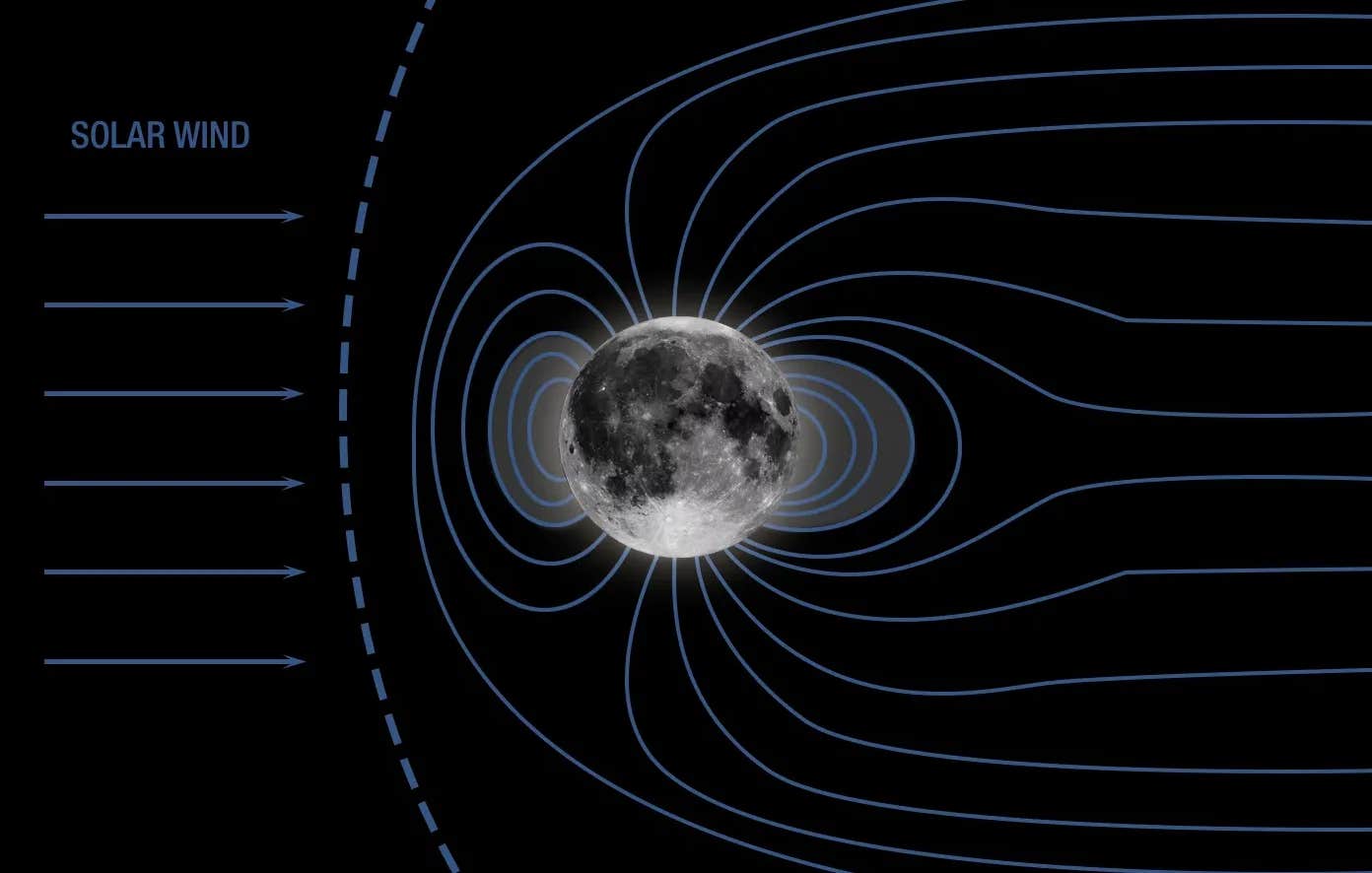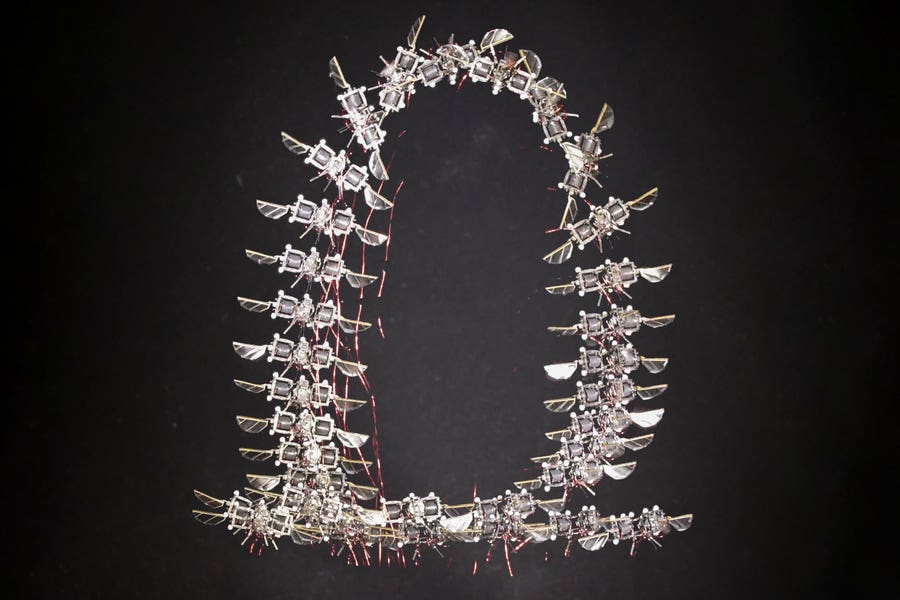The Moon once had magnetic fields as strong as Earth’s
Weak lunar magnetic field could have been amplified by massive asteroid impacts, explaining the moon’s ancient magnetism.

New study reveals how ancient asteroid impacts may have briefly amplified the moon’s weak magnetic field. (CREDIT: NASA)
The moon may be silent and still today, but billions of years ago, it likely crackled with magnetic activity. Though the moon now lacks a global magnetic field, its rocks—especially those on the far side—carry strong traces of ancient magnetism. These mysterious signatures have long puzzled scientists. How could such a small body with a weak core have created magnetic fields as strong as Earth’s?
Now, a team led by researchers at MIT may have found the answer. Their study, published in Science Advances, suggests that a weak internal magnetic field could have been dramatically amplified by massive asteroid impacts. These impacts, they propose, created clouds of electrically charged gas, or plasma, that briefly boosted the moon’s magnetic field—just long enough to leave a lasting mark in the crust.
Ancient Traces in Lunar Rocks
Magnetic clues first emerged when astronauts brought back lunar samples during the Apollo missions. Many of these rocks showed signs of strong natural remanent magnetization, or NRM. Additional spacecraft data confirmed widespread crustal anomalies—especially on the moon’s far side—that point to the presence of a powerful magnetic field between about 4.25 and 1.5 billion years ago.
Some of these rocks cooled slowly and recorded long-lasting thermal remanent magnetizations. Others likely formed almost instantly under high pressures, acquiring what’s known as shock remanent magnetization. In both cases, the rocks preserved signals of a magnetic field far stronger than what the moon’s small core should have been able to generate.
This disconnect sparked a decades-long mystery. Standard models say the moon’s core could only produce fields of about 3 microtesla—far weaker than the 10 to 100 microtesla levels recorded in the lunar samples. That gap raised a pressing question: what amplified the moon’s magnetic field?
Impact Amplification
Researchers have considered several possibilities. External sources, such as the early solar wind or Earth’s magnetic field, were too weak or faded too early. Internal sources like a magma ocean or mantle-core precession might have helped, but couldn’t explain the most intense fields.
Related Stories
That’s where the new study comes in. Lead author Isaac Narrett, a graduate student in MIT’s Department of Earth, Atmospheric and Planetary Sciences, and his colleagues believe massive asteroid impacts played a key role. “There are large parts of lunar magnetism that are still unexplained,” Narrett says. “But the majority of the strong magnetic fields that are measured by orbiting spacecraft can be explained by this process—especially on the far side of the moon.”
The team focused on the Imbrium impact basin, one of the largest known lunar craters. It formed roughly 3.7 to 3.9 billion years ago and lies on the near side of the moon. Curiously, some of the strongest magnetic anomalies appear on the exact opposite side—its antipode—near the lunar south pole. This raised the idea that the shock from a massive impact could travel through the moon and produce magnetic effects on the far side.
To explore this theory, the researchers combined two types of simulations. First, they modeled the formation of the Imbrium basin using a hydrocode called iSALE-2D. This code, developed by Katarina Miljkovic of Curtin University and others, helped simulate what happens when a 60-kilometer-wide object slams into the moon at 17 kilometers per second.
From this, they extracted data about the resulting vaporized material. This superheated cloud of plasma, made of ionized rock and gas, expanded rapidly around the moon.
Next, they turned to magnetohydrodynamic simulations using the BATS-R-US code, developed at the University of Michigan. These simulations tracked how the expanding plasma cloud interacted with an existing magnetic field generated by a weak lunar dynamo.
A Brief but Powerful Spike
Instead of relying on the sun’s magnetic field, which had proven too faint in earlier studies, the researchers assumed the moon had a weak, internal dipole field—similar in shape to Earth’s but far smaller in strength. They tested a field of 1 to 2 microtesla at the surface, which fits scaling laws for small planetary cores.
As the plasma spread, much of it rushed away into space. But a portion curved around the lunar body and slammed into the antipodal region. There, the plasma compressed the magnetic field lines, boosting the field strength by more than 20 times. In their simulations, this created a spike of about 43 microtesla—strong enough to match the magnetization levels found in ancient lunar rocks.
The spike didn’t last long. Narrett estimates the entire amplification episode ended in about 40 minutes. That raised another question: could rocks in the region actually record such a brief pulse?
The answer, the team believes, is yes—thanks to another effect of the impact.
As the asteroid struck the moon, it also sent a powerful pressure wave through the lunar body. When this wave reached the opposite side, it jittered the crust. This jolt briefly disrupted the alignment of electrons within minerals. Just as the amplified magnetic field peaked, these electrons settled again, locking in the strong field’s direction.
Benjamin Weiss, an MIT professor and study co-author, explains the process like this: “It’s as if you throw a 52-card deck in the air, in a magnetic field, and each card has a compass needle. When the cards settle back to the ground, they do so in a new orientation. That’s essentially the magnetization process.”
A Dynamo with a Twist
The study brings together two previously competing theories—the presence of an ancient dynamo and the influence of giant impacts. Rather than one excluding the other, the results show how they could work together.
Earlier estimates assumed the moon needed a powerful dynamo to explain its crustal magnetism. But these new simulations show that even a weak field could have been enough—if it was briefly amplified by the right kind of impact and aided by shock waves through the crust.
The researchers also tested different impact angles and field strengths to see how the effect would vary. They found that the amplification process works best when the impact happens at the lunar equator, where the field lines are most susceptible to compression. But even polar impacts can boost the field under the right conditions.
The team’s simulations accounted for the moon’s internal structure, including its conductive mantle and highly resistive crust. These layers affect how magnetic fields change over time. In particular, the crust tends to dissipate magnetic energy quickly, so any field amplification has to be both intense and fast to be preserved.
Signs on the Far Side
The final piece of the puzzle lies in testing the theory. The far side of the moon, especially near the lunar south pole, holds key evidence. This region, opposite the Imbrium basin, contains some of the strongest magnetic anomalies measured from orbit.
If future missions, such as NASA’s Artemis program, bring back rocks from this region, they could confirm the presence of both strong magnetism and shock features. Such samples would offer the best chance to prove whether impacts truly amplified the moon’s magnetism.
“For several decades, there’s been sort of a conundrum over the moon’s magnetism—is it from impacts or is it from a dynamo?” says MIT’s Rona Oran. “And here we’re saying, it’s a little bit of both. And it’s a testable hypothesis, which is nice.”
This new view of lunar history doesn’t just explain past mysteries—it also opens up new ways of thinking about other planets and moons. Anywhere with a weak dynamo and a history of large impacts might have followed a similar magnetic path. For now, though, the moon holds the clearest clues, waiting in silent rock layers for the next mission to bring them home.
Note: The article above provided above by The Brighter Side of News.
Like these kind of feel good stories? Get The Brighter Side of News' newsletter.



